Pssst. There is a reference list of important documents at the bottom.
Introduction
 The Des Moines Marina opened in 1970 after about a four-year process that was remarkably contentious given how we all take the place for granted these days. Back then there were no condos. Many of the residents did not want it for the same reason that people do not want Marina re-development now: They liked things the way they were.
The Des Moines Marina opened in 1970 after about a four-year process that was remarkably contentious given how we all take the place for granted these days. Back then there were no condos. Many of the residents did not want it for the same reason that people do not want Marina re-development now: They liked things the way they were.
The Marina’s purpose was to provide low-cost recreational opportunities for residents and to act as a regional tourist attraction–primarily for recreational boaters who would come here with their trailers to go fishing.
I emphasised that because ‘boating’, either sail or powered was a middle-class hobby. For many people it was no more extravagant than being in a sports league.
There’s been a certain amount of talk recently about how “the City hasn’t changed since 1962.” How Marina redevelopment has been chronically “stalled.” How it has been a series of ‘failures’ and so on.
I’ve been using the Marina for a good while and that has not been my experience. In fact, the Marina is the single most successful economic development project in our city’s history. And it is one hundred percent public; no private developers.
Ironically, the Marina was so successful that the City was able to dip into its profits for years in order to prop up core services. (Doubly ironic because most residents seemed to believe that the City somehow subsidised ‘those boat owners’, when the reverse was true. But this practice prevented the Marina from saving enough for projects like seawall and dock replacement which can no longer be put off.
Other parts of Des Moines may not have changed as much as one might like, and the downtown may not have as much nightlife going on as much as one would like, but the Marina did not spring into being all at once. Various components were added in stages in the early years. And it has, in fact, been steadily evolving and improving since the mid-2000’s. I’ve started work on this timeline, which is a beta, and will be changing, to make that case.
I think that when people talk about ‘the Marina’ they are often using it as a proxy for general frustration over a lack of economic development in the downtown. I would contend that the Marina has worked as intended. It’s now time to make some changes, but those are changes to respond to a changing world.
1978 – 1980
Work on the Fishing Pier begins with a grant project 78-027 from what is now the Recreation and Conservation Office (RCO.) This, in itself was not one ‘project’. This grant also had several requirements, which I’ll call ‘strings’.
The Tires…


Get this out of the way first, the project also included an Artificial Reef, designed by Phillipe Cousteau (legend Jacques Cousteau’s son) It was an idea popular in the early 1970’s that the EPA thought would enhance the sport fishing. (In fact, the idea was so popular, over 25,000 were placed along the Des Moines shoreline, at the Marina, Saltwater State Park and Redondo.) There are likely several hundred thousand more within the Puget Sound. Let’s ponder that for a minute: your environmental protection agency recommended a toxic bundle of tires. OK, that’s enough pondering.
Parking
The Fishing Pier also consists of the North Parking Lot–which was felt necessary to provide parking for those fishers. It is built on fill dirt, which was considered stable enough for the weight of automobiles–but not necessarily for any larger structures.
A set aside for 53 (a fairly specific number, right?) of parking spaces that, regardless of any other changes, must be maintained.
The Restroom
The parking lot also requires a restroom. And it must be sited on the parking lot.
Because the thing is, you can update the project over time, but each time you do you have to get approval from the RCO. So over time, the project file has grown pretty large.
The parking lot also had a significant impact on the North Bulkhead (the seawall) which required its own set of permitting requirements. As you may know, that seawall barely lasted 39 years and cost over 12 million dollars to replace. It’s worth mentioning because the price tag for the entire fishing pier in 1979 dollars was $454,000 (prox. $1.93M in 2023.)
The new Fishing Pier was officially dedicated on June 4, 1980, with Governor Dixy Lee Ray herself in attendance.
It’s probably easier to visualise the project rotated like this.
2001
This is my first recollection of Dry Stack Planning. (reference needed) in a meeting by then Councilmember Sheckler. This was loooooong before any notion of dock replacement.
2007
The ‘modern’ discussion of the Marina should probably begin on May 10, 2007 with the adoption of Resolution 1039 the Des Moines Marina 2007 Master Plan. Meeting Minutes.
It gives you an outline of all the issues people are discussing today:
- How the finances went off the rails.
- Why the waterside and the landside need to be re-thought, and various options.
- The notion of ‘thirds’
- The north being a public park by virtue of the grant funding
- The center being ‘commercial’, ie. a series of small retail/food businesses connecting in some way to 223rd–of which the Quarterdeck is the only realised piece.
- The south being the functional Marina, ie. boat launch, dry stack, moorage.
- What the costs look like (the Harbormaster breaks them down in a very granular way and shows financing options for both cash and debt.) This gives one a good sense of the trend line–ie. how fast these costs are increasing over time.
- How quickly the infrastructure is decaying.
- And… frankly… why we kept kicking the can down the road.
Frankly, this is the kind of meeting I have not seen (yet) in my tenure on the Council.
2008
For me this story begins in 2008–the first City Council Meeting I attended where the City Council votes to remove the Sling Launch. Up to that point, local business-wise, the City had actually been doing not half bad until whammo, The Great Recession hit.
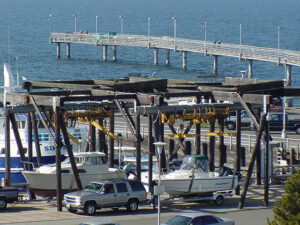
That recession was especially hard on the Marina because what people don’t seem to get now is that all the parking at the north end was designed, from day one, for boat launching. The Marina was designed as a recreational fishing destination.
The boat launch referred to as ‘the Sling’ allowed thousands of people an easy, safe, low cost way to launch their trailered Bayliners into Puget Sound. The Sling, Guest Moorage and especially cheap fuel were meant to be ‘the magnet’ that would draw visitors to Des Moines. But the fishing had been drying up for years. The number of launches of boats smaller than 24 feet declined from 5,669 in 1998 to 2,989 in 2005. And in 2008, it was running a $20,000 deficit.
At the time, removing the Sling was hugely controversial. But, again, there was nowhere near the amount of traffic necessary to have the thing break even, without raising rates so high that even more boaters would balk.
But I’m going on about the Sling because I have three main points to raise about redevelopment today before leaving the Sling.
#1 It was never about the Sling
You may not think that losing $20,000 a year was that big a deal and I would agree. But here’s the thing people don’t talk about. It was the City’s plan, as you can see in the 2007 Master Plan, to replace the Sling with a restaurant. Removing the Sling was part of a ten year plan. So the revenue was kinda/sorta a misdirection. But people were so focused on ‘losing money’ they didn’t get that. Impatient readers can fast forward to 2018 😀
#2 Subsidies…
At the time, Harbormaster Joe Dusenberry said, “I’m all about revenue.” And what replaced the Sling was a very different kind of revenue generator. Impatient readers can fast forward to 2018 😀
But, if the City felt it could not afford to lose $20,000 a year subsidising fishermen in 2008, it has absolutely no business losing $500,000-$1,500,000 a year subsidising a passenger ferry now unless we can prove that the investment will pay dividends.
The reason I’m so stroppy about the ferry now is that people are using exactly the same arguments to support the same kinds of subsidies that we used to do with the Sling. The idea was that we should not see these deficits as bad things, but rather as economic drivers which would bring in ‘thousands of tourists to spend money in the City’. Sound familiar? The City tried that with the Sling, with Guest Moorage and above all with super-cheap fuel, for years. And? It. Does. Not. Work.
#3 Asphalt
But apart from that, removing the Sling meant that there was now going to be a whooooooole lot of empty parking lot many days of the week, which is the worst of both worlds: it’s a bunch of asphalt (terrible for the environment) and it’s a bunch of unrealised potential. But potential for what? That’s the question. So, if you think about it, the whole Marina Redevelopment conversation boils down to “What do we do with all the free asphalt now that people no longer come here to fish?”
2009
 The University of Washington’s Storefront Studio (part of their CEP School) publishes a senior project re-imagining our downtown and Marina. Here is a post containing a complete hi-res copy of their ideas.
The University of Washington’s Storefront Studio (part of their CEP School) publishes a senior project re-imagining our downtown and Marina. Here is a post containing a complete hi-res copy of their ideas.
2010
In October, the City has a ceremony declaring both the Beach Park and the Des Moines Creek Trail complete. People think those building had been there forever? Nope. Even as the City struggled financially, the City continued to do some very nice things. It wasn’t like there was some ‘Dark Ages’ as you may have been told. (In fact, we had far more police officers in 2007 than today.)
2011
Now that the Sling is gone, work on sprucing up the North Parking lot begins. The entire Marina bulkhead (seawall) needs work and the public begins noticing the rapid deterioration of the creosote pilings on the north bulkhead. However, the City begins work on the central bulkhead (in front of the Harbormaster’s Office) first as that stretch also contains major electric, water and sewer lines, the loss of which would close the Marina.
2012
At their January 12 meeting, the City Council gets a second great presentation from the now defunct Public Planning Agency and UW Storefront Studio students called the Marina District Wayfinding Project. The project discusses a Marina Steps and redesigning the downtown to be more attractive to visitors.
But the main item of interest marina-wise, was renewal of our thirty year Department of Natural Resources Aquatic Lands Lease (pg 58).
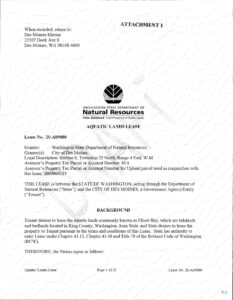
- We do not own most of the shoreline, we rent it for prox. $100,000 a year.
- Almost all marinas are Port Districts, which received more than one exemption on these fees. City-owned Marinas are not the norm and we pay a premium for that.
- The lease expires in 2041 and one of the terms of the lease is that you’re required to return it to the ‘pristine’ condition it was when you began the lease. Which makes a marina like ours essentially a forever, deal. You could, in theory, shut it down if you got tired of boaters, but then you’d need to pay to remove the jetty and the docks and the seawall, which would probably cost more than replacing the docks.
- But on the other hand, the State and the Federal government have taken a dim view to jettys and sea walls and marinas in general. So they keep upping the permitting fees.
If that sounds like a mixed bag, you’re catching on. There is no ‘off switch’ and the pain factor only increases with each passing year.
The Council also votes to remove Passenger Ferry from its Legislative Agenda. Mayor Pro Tem Matt Pina says “Because there’s no hope it will happen.”
2013
April 6 (All Options On The Table)
Once or twice a year, the City Council used to do off-site meetings, typically on Saturday mornings at the Senior Center, known as Council Retreats. All meetings of the Council are technically ‘public meetings’, but my impression is that these ‘retreats’ were at least partly held off-site because there were no cameras. 😀 CMs are remarkably candid, taking risks that you’d never see today. And they are real discussions. There’s no ‘calling on people’. People just talk. The downside is that almost none of the public ever attended these meetings and there are only brief minutes (and sometimes audio). But these meetings are where a lot of the key planning ideas emerge because it was the one place where CMs felt they could really ‘let their hair down’.
At a series of meetings, starting with the all options on the table Retreat of April 6, the City put forward a series of options for addressing the problem, including several Marina ideas such as:
- Taking the Marina private (like Poulsbo currently does)
- Ending the Marina entirely and consider other uses for the land
- Creating a combo Marina and Parks Department, essentially reconceptualising the entire Marina as primarily a ‘park’
- Moving City Hall to the Marina floor and opening up 11th Ave. for economic development.
August 8
City Council votes to end the Public Planning Agency.
2014
At the City Council’s November 15, 2014 City Council Retreat, the Council decided that the Marina would continue to operate and be operated by the City.
- That will require a dock replacement strategy.
- The Harbormaster informs the Council that using Marina money to prop up the General Fund is no longer an option.
- The Finance Director also recommends setting Redondo apart as a separate accounting fund since it does not contribute materially to the Marina revenue stream.
2015
May 14
Harbormaster Joe Dusenberry presents, what looked like to me at the time, a fairly sensible a la carte plan for dock replacement (links to video, Packet and presentation.) It kept the dock finances separate and did not pretend to address big ‘plans’. The City got yelled at because part of it depended on raising fuel and moorage rates closer to (gasp) market rates! 😀
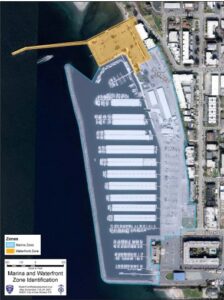 IMPORTANT: The Marina is managed as an Enterprise Fund, which means a for-profit and self-sustaining business run by a government. Think: US Post Office. An Enterprise Fund is supposed to live or die on its own and all profits are also supposed to be plowed back into the EF and not used by the General Fund. Back in the day, obviously that did not happen. 😀
IMPORTANT: The Marina is managed as an Enterprise Fund, which means a for-profit and self-sustaining business run by a government. Think: US Post Office. An Enterprise Fund is supposed to live or die on its own and all profits are also supposed to be plowed back into the EF and not used by the General Fund. Back in the day, obviously that did not happen. 😀
Going back to the Sling, at one time, the entire Marina floor was part of ‘the Marina’, ie. that Enterprise Zone. The accounting made sense because everything was about boats and fishing, including the parking. But once the Sling went away, that was no longer the case.
As this presentation shows, as of 2015, the City is breaking the Marina into separate ‘zones’, with the North Parking Lot and Fishing Pier areas meant to be set aside in a Public Benefit Zone.
Later, that area becomes its own separate fund known as the Waterfront Zone, which is not part of the Marina financing per se. So, in effect, that orange area is no longer considered to be a part of the Marina.
Similarly, the area previously occupied by the Sling, stretching back to Parcel A and the backside of 223rd was now being considered for economic development.
Once the Marina footprint started to be used for several different things, including paid parking, a restaurant, SR3 and events, the accounting has become commmmplicated. And as we consider doing even more ‘stuff’ on the Marina floor, it will become even more so.
So, one planning idea to explore would be to formally re-organise our funds (accounting system) to specify what each portion of the Marina may be used for. In other words, make the accounting literally map onto the map. 😀
July 1
King County publishes a county-wide ferry demand study (prepared by KPFF, the same engineering team the City has used many times) with the goal of expanding its Water Taxi System. Des Moines does not make the cut. Their analysis is clear: there is no commuter demand for ferry service to/from Des Moines. The City should instead focus on providing shuttle service to the Link Light Rail at Angle Lake–and then the future Kent Des Moines stations.
-
- “Des Moines [was] eliminated in the last step in the evaluation process due to the low ridership demand forecasted, which had a direct impact on the net cost of operation evaluation criteria.”
- “Because light rail will be located in close proximity to Des Moines, a POF may not be viable. Also, The City of Des Moines has voiced concern over POF parking at the marina.”
2016
November 17
At this meeting (Agenda) the City Council approves two relevant items:
- Using a $60,000 Port of Seattle ‘Century Agenda’ economic development grant to pay for a consulting team, led by Robert Holmes (THG The Holmes Group) to study Marina Redevelopment. In the contract, The Embarcadero Hospitality Group (the winner of the November 18, 2022 RFQ bid for Parcel A) is listed as one of the “team members.”
- A highly controversial Paid Parking concept at the Marina at an estimated cost of $700,000. One main argument is to provide financing for upcoming dock replacement. When implemented, technical problems begin almost immediately. According to the City, it seems that the product chosen has been designed more for indoor use. Subsequent revenues average $100,000/year when in service. Residents at the Marina howl about removing/replacing the system as they claim it provides dramatically improved security. Since the PD does not keep sector-specific records, it is difficult to test that claim, but I’ve done several single-month requests for calls for service and, sorry guys. It ain’t necessarily so.
2017
March 3
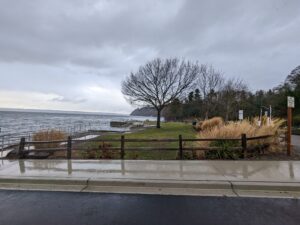 Former mayor Don Wasson dies in 2016, leaving his iconic blue house at the front of the Beach Park to the City. At this meeting, the Council votes to remove the house, which is converted to the lawn at the west corner of the beach park.
Former mayor Don Wasson dies in 2016, leaving his iconic blue house at the front of the Beach Park to the City. At this meeting, the Council votes to remove the house, which is converted to the lawn at the west corner of the beach park.
August 19
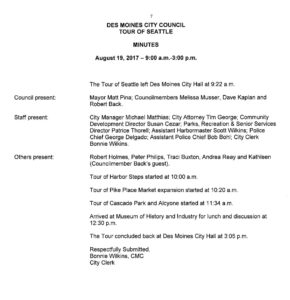 The City Council takes a tour of The Harbor Steps in Seattle with Robert Holmes and guests Peter Philips, Andrea Reay (Southside Chamber of Commerce) and candidate Traci Buxton.
The City Council takes a tour of The Harbor Steps in Seattle with Robert Holmes and guests Peter Philips, Andrea Reay (Southside Chamber of Commerce) and candidate Traci Buxton.
October 17
The City rents an Argosy Cruise ship for one night and holds a town hall on board at the guest moorage. There are no recordings and I can’t find promo pictures. But this is the origin of the idea of having visitors choose ideas using ‘stickers’ as at the September 27, 2022 Community Meeting. To my mind, this was the only real ‘town hall’ of this process.
In later City Council meetings, the City makes various claims of up to 300 people at this event. I was there. The Sign In Sheets say 135.
October 12
City Council Meeting. We accept our second grant from the Port of Seattle to study Marina Redevelopment feasibility.
2018
July 26
The City updates its six year Shoreline Master Plan. There is one public comment. (Moi.)
Environmentally speaking, the Marina is a funny thing. The reason it is so hard (and expensive) to obtain permits to do any work along a boundary between land and water (aka ‘shoreline’) is that scientists would much prefer no development along shorelines; no hard barriers at all. And since everything in the water wears out, that gives the government frequent opportunities to punish anyone who tries. The trend will be to remove seawalls and dams and any man-made objects on the shoreline. I doubt anyone will ever build another marina like ours anywhere along the west coast of America.
Ironically, from the State and Federal governments’ points of view, that makes the Marina one of the better places to put commercial stuff along the water here. Because, hey, that shoreline is already screwed up. 😀
They don’t want any new seawall, but if you already have a barrier and you can’t be encouraged to remove it, the strategy is to concentrate all your development within that zone.
So long as we have that hard seawall and jetty, which are the essence of the Marina, commercial development will likely be tolerated anywhere within the land side footprint.
The real question will be whether or not developers will want to do so if there is evidence of regular flooding in areas like the North Parking Lot and Beach Park. Will we have the stormwater and sewer capacity to keep the entire Marina floor and Beach Park dry as tides increase? And if those services are more costly, will developers want to pay those expenses?
September 6
The current ‘plan’ which we can call “Holmes” and “Skylab” began at this Study Session referred to as “Phase II”.
October 26
 The Quarterdeck ribbon cutting ceremony. The City offers owner Ken Rogers a five year lease at $320 a month based on the minimal square footage occupied by the 20′ x8′ container. Over time, the City offers free use of surrounding area totalling almost 9,000 square feet, but that is not included in any formal agreement.
The Quarterdeck ribbon cutting ceremony. The City offers owner Ken Rogers a five year lease at $320 a month based on the minimal square footage occupied by the 20′ x8′ container. Over time, the City offers free use of surrounding area totalling almost 9,000 square feet, but that is not included in any formal agreement.
Now, it never seems to come up in planning discussions that the Quarterdeck is the restaurant the City proposed to replace the Sling. Nobody seems to wonder why a moveable container is still the centrepiece of the entire Marina redevelopment proposal. But the area the Quarterdeck occupies is only available because the City chose to remove the Sling.
And that begs another comment on the value of a public planning commission:
If you really buy into Harbormaster Joe’s quote from 2008, “I’m all about revenue” (which I do, by the way) you have to ask: how much revenue does every item on the Marina floor (including the Quarterdeck) generate for the City? Is that spot the highest use for that land? I have to ask because the City was absolutely ruthless in removing the Sling in 2008–an essential element for a working marina–even though it was losing relatively small amounts of money. Even then, the City was shifting the purpose of the Marina to favour other functions (a restaurant, farmers market, SR3, ferry, etc.) which are also heavily subsidised by the City. But you can never stop and think about this because doing so makes one sound ‘mean’. (You hate seals, you hate the Quarterdeck! No, I hate not having a plan.)
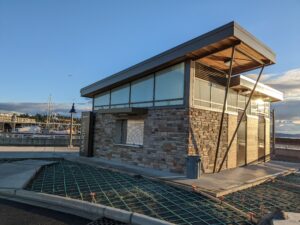
And that is why you want a public planning commission. You want everyone to decide what we want the Marina to be–every element. But instead, what we have done over time, at every turn of the road, is make separate decisions. And by doing so, we’ve allowed the Marina to be designed by someone else, or worse become a mish mash of ideas such as this million dollar idea. But since it happens so slowly no one notices.
2019
September 19
The City also does a reprise of the 2017 Argosy Cruise presentation at the Des Moines Yacht Club. Also not recorded. Same posters. Same stickers. They claimed to have up to 500 participants. But the Marina Redevelopment Sign In Sheets show only eighty four (84) attendants.
September 26
WATCH THIS: At September 26, the City Council holds a Study Session and presentation to the City Council by Mark Bunzel of the Waggoner Group and Robert Holmes. In my opinion, this meeting, along with the 2015 meeting are the most important discussions on Marina Redevelopment. They are both worth an hour of your time. Bunzel, and especially Holmes, pitch the idea of not only dock replacement, but of making the Marina a destination. Hotels. Tie-ins with Sea-Tac Airport. Hard. They promise detailed forecasts every five years to support his ideas. So far, I have not seen these. So far, I have only seen financial projections on the dock replacements and revenue projections on in-water moorage.
The meeting discusses the goals of dock replacements, and Strategic Planner Susan Cezar discusses the poll of all those ‘stickers’ people have asked about. Ironically, both she and City Manager Matthias talk about the importance of ‘public space’.
Let’s talk about SR3…
 Also of note in 2019, there is actually one more community meeting concerning the Marina which you may not have heard about. This one took place at the Beach Park Auditorium and it was intended to address public concerns about moving SR3 to its current location on the Marina floor. Originally, Sealife Response Rehab and Research (SR3) had planned to lease a space at 605 223rd Street (the old boat dealership, now occupied by Harper Studios.) After some emails between the SR3 manager Casey McLean and now Mayor Mahoney, the City Manager announces a plan to offer that spot on the Marina floor.
Also of note in 2019, there is actually one more community meeting concerning the Marina which you may not have heard about. This one took place at the Beach Park Auditorium and it was intended to address public concerns about moving SR3 to its current location on the Marina floor. Originally, Sealife Response Rehab and Research (SR3) had planned to lease a space at 605 223rd Street (the old boat dealership, now occupied by Harper Studios.) After some emails between the SR3 manager Casey McLean and now Mayor Mahoney, the City Manager announces a plan to offer that spot on the Marina floor.
This meeting was not recorded. Most of the Council was there along with City Manager Matthias. The crowd was almost entirely condo owners and they were not particularly thrilled. Apparently, the City thought of the idea as a tremendous marketing opportunity, although the location manager made it clear that the animals must have no contact with human beings other than caregivers. Not audio, not visual. Nothing. Hence the opaque fencing.
I asked then Mayor Pina to explain how this happened and he said, “It’s an interesting story…” 😀
October 12
The City Council receives a proposal from a digital marketing firm Diedrich RPM (DRPM) out of Burnsville, MN. The Council authorise them to come back with a proposal to do a full-on private passenger ferry demand study.
December 5
The City Council receives a second presentation from DRPM. The Council authorises a private passenger ferry demand study.
2020
The Puget Sound Regional Council (PSRC) conducts a very thorough analysis of the ferry system for the express purpose of improving commuter service throughout Puget Sound. Des Moines does not make the cut–for the same reasons King County mentioned (low demand, better options via Link Light Rail.)
After numerous demands from moi, the City finally releases the results of that 2019 Diedrich RPM private ferry study, based on a survey of 327 people throughout King County. The City Manager declares this is conclusive proof that there is a strong demand for a private ferry here but neglects to mention either the PSRC Study (above) or the more specific 2015 King County Study (above) which say otherwise.
2021
In 2021, the city really got cranking on Marina planning. And I’m pausing here to mention an initiative by former City Manager Piasecki which seems prescient. He valiantly tried several ideas to reform various City Council processes. Some took hold. One which did not was to try to encourage ideas to move forward through a single decision path. That is, unless absolutely necessary, an idea should only be heard by one committee.
At the time, I thought it was mainly to avoid duplicative effort, which is not nothing–he didn’t want to see staff making the same presentation to three different committees when it only needed a decision from one. But today, with the Marina, it has created a nasty problem of public engagement, or lack thereof.
As you’ll see if you watch any of the videos in 2021, I saw basically every one presentation concerning the Marina at least four times.
- First, it would be run by the DMMA. Think about that, the City would run their ideas by the boat owners before they would show it to the City Council! That created the notion that ‘public engagement’ meant the boat owners, 82% of which are not residents of Des Moines!
- After that feedback, a polished version would be heard by the Municipal Facilities Committee, which oversees City property. Jeremy Nutting is chair.
- And then, the same staff would have to give the same presentation to the Economic Development Committee, which is also chaired by CM Nutting. The idea being, of course, that the Marina was going to be the key driver of the City’s economic development goals.
- And then the same staff would have to give the same presentation to the full Council. (There was more than one meeting where staff gave the same presentation on the same day at 3:00PM, then 4:00PM, then 5:00PM.)
But that isn’t the good part. The part that got on my last nerve was how often the City and my colleagues would tell the public about all the ongoing public engagement. Sure, if you call giving the same presentation four times to the same crowd of electeds and non-residents ‘engagement’. 😀
February 7
The City presents the Moffat & Nichols Des Moines Marina market and financial study, which covers costs and revenue potential for dock replacement, ie. in-water moorage. But critically not for dry stack storage, which is a key revenue source for most marinas.
February 25
A presentation by Dan Brewer to the Municipal Facilities Committee.
March 25
Second presentation to Municipal Facilities Committee by Dan Brewer.
At the tail end (47:29), Luisa Bangs says to the marina assistant manager that she will discuss an issue ‘off-line’. I mention that because I’ve been explicitly forbidden from speaking with any city staff–and told that no councilmember may do so. Which is simply untrue. This is in an ongoing violation of the ICMA Code of Ethics.
March 27
 The Waggoner Group issues their report Marina Redevelopment Assessment and Strategy Phase II, which calls for an Adaptive Purpose Building for dry stack storage and eliminating or redesigning the Harbormaster House early in the design process as possible. It also says that a passenger ferry service would require changes to the Marina.
The Waggoner Group issues their report Marina Redevelopment Assessment and Strategy Phase II, which calls for an Adaptive Purpose Building for dry stack storage and eliminating or redesigning the Harbormaster House early in the design process as possible. It also says that a passenger ferry service would require changes to the Marina.
April
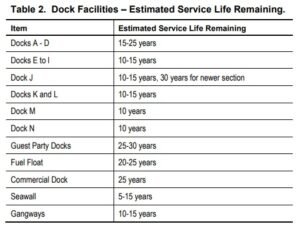 Reid Middleton (the company that originally engineered the Marina) issues its December 8, 2020 Marina Service Life Report.
Reid Middleton (the company that originally engineered the Marina) issues its December 8, 2020 Marina Service Life Report.
May 21
The City conducts a public outreach campaign and publishes a list of questions and answers concerning Marina Redevelopment. I learn that this outreach was confined solely to the prox. 750 boat owners.
At least 82% of boat owners are not residents of Des Moines.
From the Packet:
The City has conducted several large scale community input events (over 200 people attended the Argosy Community Open House in October 2017 and the Yacht Club Open House with over 300 people, in addition to working closely with the Des Moines Marina Association leadership and membership.
Anyone who has ever been on the Argosy or inside the Des Moines Yacht Club knows that those numbers are impossible.
The City has previously engaged in two studies focusing on design feasibility and financial feasibility feasibility, in addition to the preliminary work, we have done a utility survey, geotech analysis, and identified land use permitting required for development.
If we’ve already done those studies why did we not catch that before we published our RFQ in September 2021?
May 21
The City presents that 2019 Diedrich RPM private ferry study. Again, it is a survey of 327 people throughout King County. The City Manager declares this to be conclusive proof that there is a strong demand for a private ferry here but neglects to mention either the 2020 PSRC Study (above) or the more specific 2015 King County Study or the 2012 Council vote to permanently remove the discussion from our legislative agenda.
September 2
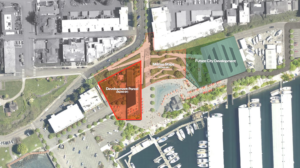 The Council votes for a sixty day Request for Quote process to find a developer for Parcel A with a strong preference for a ’boutique hotel’. (That concept is not new. It actually was discussed by a Council committee study in 2012 led by Melissa Musser.)
The Council votes for a sixty day Request for Quote process to find a developer for Parcel A with a strong preference for a ’boutique hotel’. (That concept is not new. It actually was discussed by a Council committee study in 2012 led by Melissa Musser.)
November 18
The City Council receives the results of the September 2nd RFQ process. The RFQ was sent to 2,500 companies, only three submitted serious proposals and two wanted to change the proposal to fit their needs. The remaining proposal is from a tag team from The Embarcadero Hospitality Group and McBride Cohen. Kimpton is also in there someplace? 😀
Silly me, I assume that EHG is the lead because
- Their name is the lead on the RFQ.
- The City sent its top staff to spend the weekend at one of their hotels in Oregon, not the Point Ruston property developed by McBride Cohen.
 The Council votes to give the City Manager authority to enter into an exclusive negotiation on Parcel A. On the list of references for Embarcadero Hospitality Group is our Marina Consultant, Robert Holmes.
The Council votes to give the City Manager authority to enter into an exclusive negotiation on Parcel A. On the list of references for Embarcadero Hospitality Group is our Marina Consultant, Robert Holmes.
2022
February 7
The City presents a boating financial market study concerning dock replacement. From reading this report, the outlook for boat ownership does not seem as rosy to me as previous study sessions seem to have indicated. (Well, except for this guy. Sorry, can’t help myself. 😀 )
I keep beating on this, but back in the day, ‘boating’ had a completely different demographic. It was for schleps like me 😀 ; a mass-market, middle class hobby. Many union wage jobs could pay for in-water moorage in Des Moines; that was kinda the point of having a community marina! That is simply no longer the case. Boats today cost a lot. In-water moorage is getting pricier and pricier because the demand is so high. However, that demand is coming from a demographic that has larger and larger boats and is getting older and older.
Many marinas now make a substantial portion of their income from dry stack storage–which is perfect for craft under 30′. If there truly is a younger demo coming into boating, dry stack storage may be the best solution for them and by far the most lucrative use of land for the City that would maintain the Marina floor for its intended purpose: boating. The discussion of dry stack demand was left for the future.
April 7
City Manager Michael Matthias provides an update on the Marina Redevelopment RFQ for Parcel A, we approved in November 2021. He announces that the City and the developer have come to an agreement, which has been vetted by outside attorneys. He states that Loren Cohen of McBride Cohen, developer of Point Ruston, has visited City hall and met with Mayor Mahoney to deliver a $35,000 ‘good faith’ payment. He does not take questions and does not mention ‘Embarcadero’, whose name was the lead on the winning proposal from November. The Point Ruston development was indeed developed by McBride Cohen, not Embarcadero. But the RFQ presents both companies almost independent of one another. For example, there are no references to Point Ruston or McBride Cohen on the EHG web site, however The Holmes Group is listed as a Real Estate Advisor on one of their projects.
April 13
The City Manager asks for (and is granted) $985,000 to create a sixty day Ferry Pilot program. My take? This is insane.
June 1
Engineers deliver a report on the Tenant Boat Hoist, informing the City that it is unsafe and should be taken off-line.
The City moves its replacement from Tier 2 (10 year) to Tier 1 (1-5 years) in its master plan.
Without the Sling, the Tenant Hoist is the only way for small boat owners (those using the current Sheds) to launch. That structure had been on watch for many years, so I’m uncertain as to why it was not placed in Tier 1. How this new cost will affect the dock replacement concerns me because that initial tranche of funding (meant for L, M and N) is the only financing we have at the moment. Also, this type of hoist is incompatible with a dry stack system, and the Council has, as of yet, not received any discussion of costs or architecture.
June 23
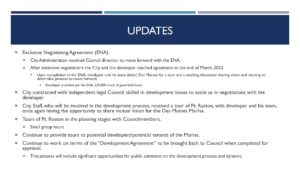 At the June 23 City Council Meeting, the City Manager gives a recap of the Marina Redevelopment Update he presented in April, announcing that negotiations on Parcel A were successfully concluded on March 23rd. The Council is invited for a tour of Point Ruston to meet the developer. However, the actual agreement is not shown to the City Council.
At the June 23 City Council Meeting, the City Manager gives a recap of the Marina Redevelopment Update he presented in April, announcing that negotiations on Parcel A were successfully concluded on March 23rd. The Council is invited for a tour of Point Ruston to meet the developer. However, the actual agreement is not shown to the City Council.
Also announced are several staff changes: Ms. Cezar is retiring. City Clerk/Communications Director Bonnie Wilkins becomes Chief of Staff, Assistant City Clerk, Taria Keane becomes City Clerk, and Chief of Operations Dan Brewer becomes Executive Director of Marina Development.
July 16
The City Manager asks members of the City Council to “hold” August 18th for a meeting with “the developer” (presumably Mr. McBride Cohen?)
August 1
The Ferry Pilot begins. After thirteen days, the City Manager declares the program a complete success.
August 13
The Point Ruston tour is cancelled. No explanation is given.
September 22
The City formally cancels its Exclusive Negotiating Agreement (ENA) with McBride-Cohen for Parcel A and issues them a refund, but without notifying the City Council. One reason given is that their proposal called for expanding beyond Parcel A.
September 27
 On September 27, the City holds the first Community Meeting since 2019 at the Senior Center. There is almost no promotion for the event so attendance is perhaps 60 people. Once again, it is not recorded. (The above link contains cell phone audio and transcript.)
On September 27, the City holds the first Community Meeting since 2019 at the Senior Center. There is almost no promotion for the event so attendance is perhaps 60 people. Once again, it is not recorded. (The above link contains cell phone audio and transcript.)
Despite the June 23, presentation, the Mayor and City Manager announce that there is a radically different plan, with a hotel in the North Parking Lot. Only twelve (12) minutes of questions are permitted. There is no explanation for abandoning the Parcel A negotiation.
November 9
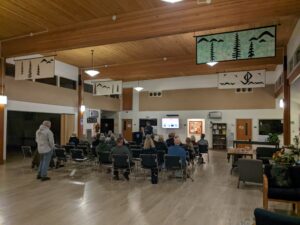 Mayor Mahoney gives another un-recorded presentation (transcript), again at the Senior Center, for the Des Moines Marina Association. He reveals new information as to the hotel planning. Apparently, the new plan is based on feedback from the winning developer of Parcel A.
Mayor Mahoney gives another un-recorded presentation (transcript), again at the Senior Center, for the Des Moines Marina Association. He reveals new information as to the hotel planning. Apparently, the new plan is based on feedback from the winning developer of Parcel A.
THIS MATTERS: In other words (and this is important) the developer decided after agreeing to create a spec based on the City’s RFQ, and after we supposedly had a signed agreement from March, 2022, that they too did not want to abide by the parameters the City Council approved. This creates the appearance that they used the initial RFQ process in hopes of influencing a second RFQ–including a hotel in the north parking lot–to be more to their liking.
OCTOBER 27
In June, Quarterdeck owner Ken Rogers announced he is selling the business to an employee. The Council approves a new 5+5 lease renewal for $380/month. The new agreement still includes only the area occupied by the container. However, both the current and new owners express confidence that they will retain control of the current surrounding space.
December 1
- The City presents a final report on the Ferry Pilot program. The City Council votes to start a second version of the program in April, 2023.
- Robert Holmes’ (THG Consulting) contract for ongoing Marina consulting is extended and increased to $5,000/month. Addendum 3.
- Peter Philips (also publisher of City Currents Magazine) and our representative on the Sea-Tac Airport Community Round Table (StART) also receives an extension and increase to his ongoing contract for Ferry Consulting to $5,000/month. This raise (Addendum 3) is his third since the contract was signed in 2019 and the second of 2022..
December 8
The City announces that the last round of bonds used to finance Marina repairs (2007) are now paid in full. That, combined with the City’s improved credit rating will provide the next round of GO Bonds for the Marina. That is currently the sole financing option for Tier 1 (L, M and N docks–and now the Tenant Boat Hoist.)
A note on bonds. Sometimes I will hear from residents a rumour that the City has a bonding capacity of something like $100,000,000. Woo hoo! 😀 So why don’t we just borrow the money to replace the docks?
That borrowing capacity is technically true. But that’s like having a huge credit card limit. Doesn’t matter. What matters is your monthly payment. Even with our improved credit rating and paying off our existing Marina debt, we can only afford to borrow enough to work on a very limited portion of all the projects people talk about. Maybe L, M and N. The boat hoist? Dunno. And all that other stuff, like bio-swales and steps and ferries and whatever? Unknown unknowns.
As of 2021, the City was pushing economic development on the Marina Floor because that was supposed to be the source for dock replacement. And the recent failure of the Tenant Boat Hoist has made that urgency very concrete. Thus, the phrase “the Landside must pay for the Waterside.”
It is the pressure to replace the docks, with no clear path to financing, which drives the entire Marina discussion.
2023
January 12
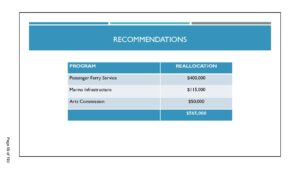 The Council receives an ARPA Spending Update from new Finance Director Jeff Friend. The City Manager proposes to ‘re-allocate’ $565,000 of that money: $400,000 to use for Phase II of the Ferry in April and another $115,000 for something called “Marina Infrastructure.” It is difficult to give a definitive number, but that brings the amount we have either spent or budgeted for a ferry to at least $1,720,000, on $89,000 in revenue.
The Council receives an ARPA Spending Update from new Finance Director Jeff Friend. The City Manager proposes to ‘re-allocate’ $565,000 of that money: $400,000 to use for Phase II of the Ferry in April and another $115,000 for something called “Marina Infrastructure.” It is difficult to give a definitive number, but that brings the amount we have either spent or budgeted for a ferry to at least $1,720,000, on $89,000 in revenue.
| Appx Amount | Notes | ||
|---|---|---|---|
| 2019 | Diedrich RPM Private Ferry Demand Study | $35,000 | Diedrich RPM Final Study |
| 2019-2023 | Peter Philips Consulting cumulative fees | $147,300 | Contract + 3 Amendments |
| 2022 | April 7, 2022 60 Day Pilot Program | $975,000 | April 14, 2022 Passenger Ferry Pilot Test Funding |
| 2023 | February 2 ARPA re-allocation | $400,000 | 2023 ARPA update and recommended reallocation |
| Grand Total | $1,557,300 |
January 26
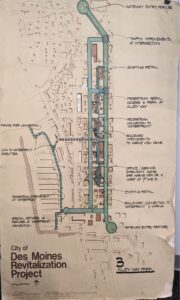 At our Marina Study Session (Agenda/Comments/Correspondence) the City announces it has already cancelled its RFQ with Embarcadero-McBride Cohen and refunded their $35,000. Plans for a hotel in the North Parking Lot and Parcel A are (for now) on hold.
At our Marina Study Session (Agenda/Comments/Correspondence) the City announces it has already cancelled its RFQ with Embarcadero-McBride Cohen and refunded their $35,000. Plans for a hotel in the North Parking Lot and Parcel A are (for now) on hold.
In every in every planning stage since Waggoner was first engaged, the City has pushed the notion of ‘public/private partnerships’ and in fact, in the RFQ developers were encouraged to combine the Marina Steps in with their Parcel A proposals. However now, the City says that it is committing to a 100% publicly funded project focusing on the Marina Steps and will return to Council for direction on February 2nd. The recommended motion in the February 2 packet calls for a feasibility study.
January 30
The City releases the March 24 2022, McBride Cohen Exclusive Negotiations Agreement and the September 22, 2022 cancellation and refund. Which is nice. Funny thing though: Why did the City cancel and refund their money and then, five days later on September 27th have a community meeting talking up the very features they objected to?
February 2
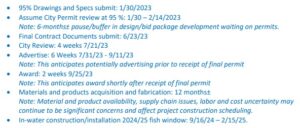 In the February Harbormaster’s Report, engineering firm Moffat & Nichol are at 95% complete on plans for replacing L,M,N docks with uncovered moorage.
In the February Harbormaster’s Report, engineering firm Moffat & Nichol are at 95% complete on plans for replacing L,M,N docks with uncovered moorage.
February 14
In response to my public records request, the City Attorney sends the Council three documents:
- A 06/22/22 Draft Agreement
- A 3D rendering of a Mixed Use Parking Garage on Parcel A alongside a very crude ‘Steps’
- A 2D outline of that project and a hotel–similar to what you saw at the September 27 2022 Skylab drawing.
He also includes this warning:
Because this was an initial draft that did not comply with the scope of the RFQ, we are asking that these not be shared publicly. Additionally, the developer may claim that the renderings are proprietary and contain their work product which could lead to a claim against an individual who were to share them. As you know, there has been a lot of misinformation conveyed to the public about Marina Redevelopment that has caused and continues to cause unnecessary confusion and dismay. Your assistance in ensuring that only accurate and relevant information is conveyed is appreciated.”
Public documents my heinie. The only ‘dismay’ I have is in trying to understand why we had an agreement in June, 2022, which is then cancelled on September 22, and then we have a community meeting five days later announcing the very features that had just been cancelled!
June 9
The Point Ruston properties are put into receivership.
“The Pierce County Superior Court has appointed a receiver for seven properties affiliated with the developer of Point Ruston, the 97-acre residential, retail and office development on Commencement Bay.
The court put the properties into receivership in May after a lender, TerraCotta Real Estate Services, sued to collect $73.8 million in debt owed on the properties, which are associated with Loren McBride Cohen, owner and CEO of the McBride Cohen Co.”
December 7
The City Council receives a preview of the 2024 Marina Master Plan Update
2024
February 7
The City hosts of Community Meeting at the Beach Park to unveil the Marina Steps Project. Public attendance is about 60. The design is said to be at 30%.
Marina Steps Community Meeting Post Game
2025
January 23
The Council approves the contract to replace L, M & N Dock. Alone among the other projects paid for with bond money, it comes in under budget!
February 6
At our Study Session – 06 Feb 2025 – Agenda the Council has a contentious and complex discussion on how to prioritise spending the remaining bond money.
- The Council votes to make replacement of the Redondo Fishing Pier its main priority and approves a new design that will look identical. The cost savings will come from a lower cost structure that utilises wider i-beams.
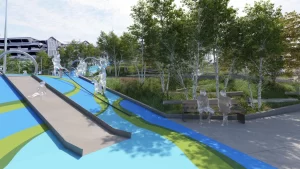 The Council also votes to spend $100,000 on a ‘value engineering’ consultant to come back with a Marina Steps re-design that can conform to the remaining moneys. This is labeled the ‘no-sprinkles’ version. Although we can’t know what this new version will look like, it is implied that the cost savings will come by removing ‘sprinkles’ such as the Spray Pad at the bottom and Climbing Path – items I had wanted to be removed from the beginning in favour of a more simple design. I vote ‘no’. Not a fan of the Steps as designed and see this is as a sunk-cost-fallacy.
The Council also votes to spend $100,000 on a ‘value engineering’ consultant to come back with a Marina Steps re-design that can conform to the remaining moneys. This is labeled the ‘no-sprinkles’ version. Although we can’t know what this new version will look like, it is implied that the cost savings will come by removing ‘sprinkles’ such as the Spray Pad at the bottom and Climbing Path – items I had wanted to be removed from the beginning in favour of a more simple design. I vote ‘no’. Not a fan of the Steps as designed and see this is as a sunk-cost-fallacy.- Instead, I propose that the Council set aside $1,000,000 towards rebuilding the small boat launch – in order to get that done at the same time as the L, M, N dock replacements. This is complicated: any in-water work requires a very complex permit. Including this work now would have made a Dry Stack system possible within 12 months. By not setting aside money now, we risk requiring a new permit and having to delay that new revenue by five years.
February 13
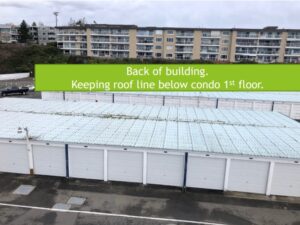 The City Council decides to do another feasibility study on Dry stack. As there have been for 25 years, concerns over blocking the views of about 20 Condo owners are raised. Boo.
The City Council decides to do another feasibility study on Dry stack. As there have been for 25 years, concerns over blocking the views of about 20 Condo owners are raised. Boo.
However, the City Manager also informs the Council that removal of the failed small boat launch can also be done by the same contractor doing the L,M & N project. Yeah.
March 6
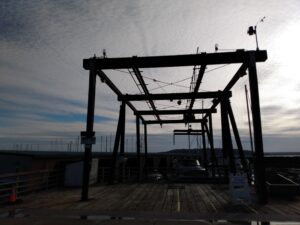 City Manager Caffrey informs the Council that removal of the old boat launch will, like the L,M & N docks be done under budget and on time. It’s as if the universe is saying, “In-water work, good. Other stuff? Not so good.” 😀
City Manager Caffrey informs the Council that removal of the old boat launch will, like the L,M & N docks be done under budget and on time. It’s as if the universe is saying, “In-water work, good. Other stuff? Not so good.” 😀
Documents Referenced in this article
- Des Moines Marina Steps Public Forum Presentation-02.13.2024
- 2024 Marina Master Plan Update 12.07.2023 Finalized
- Corrected Marina Page
- Marina Redevelopment Sign In Sheets
- 05102007-minutes (Marina Master Plan) 2d0e7b32-e46f-484a-8de5-5190c58373eb
- 01262023-Marina Redevelopment
- Waggoner Marina Redevelopment Phase II
- Des Moines Marina Enhancement Plan
- 5651-S.SL
- Resolution No. 1039 – adopting the Updated Marina Master Plan for the Des Moines Marina (1)
- des_moines_marina_boat_lift_inspection_2022.06.01
- 211150_des_moines_marina_planning_study_final_rev1
- draft_des_moines_marina_market_and_financial_study_02_07_2022
- City of Des Moines Marina Redevelopment Update
- May-14-2015-City-Council-Packet-Marina
- Marina Financial Plan 2015-Pages from May 14, 2015 City Council Packet
- The Redevelopment of Des Moines Marina Assessment and Strategy Phase 2 (Marc Bunzel/Waggoner)
- Marina_Layout_Update
- City’s Response to the Marina Tenant Association Letter 05.05.2022
- City Council Marina Dock Replacement Presentation Part I Feb 10, 2022
- Des Moines Marina Market/Financial Study 02/07/2022
- Marina Enterprise Presentation_Final (002)
- DesMoinesMarina-20
- 2021 Draft Marina Master Plan Update
- Des Moines Marina Master Plan Update Comments Questions Answers
- Des Moines Marina Master Plan Update Questions and Answers
- Marina Redevelopment Phase #2
- Municipal Facilities Committee Presentation (Des Moines Marina Master Plan Update)
- marina-
- Marina Development Presentation Bunzel Waggoner
- Marina Feasilibity Study Phase 2 Final Report – 10.23.2018_201811201504577803
- Marina Development Community Meeting 09.19.2019
- Marina-Beach Park Paid Parking
- 2015 King County Interim Report On Ferry Expansion Options For Marine Division KPFF
- UW-Marina_District_Wayfinding Project-Pages from January 12, 2012 City Council Packet-2
- 2007 Des Moines Marina Master Plan
- 1978 RCO Project #78-027 The Des Moines Fishing Pier
- Marina Opening Day Newspaper


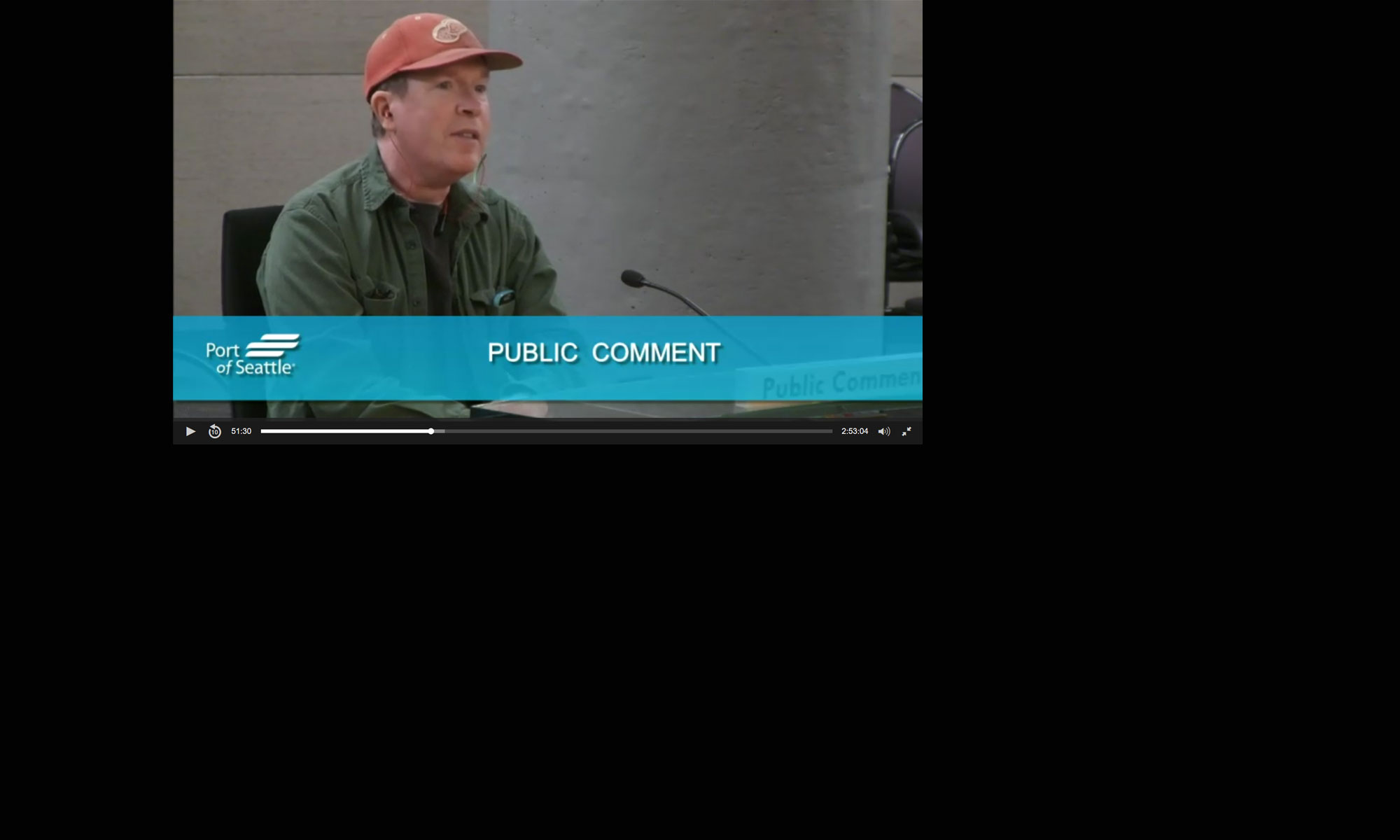
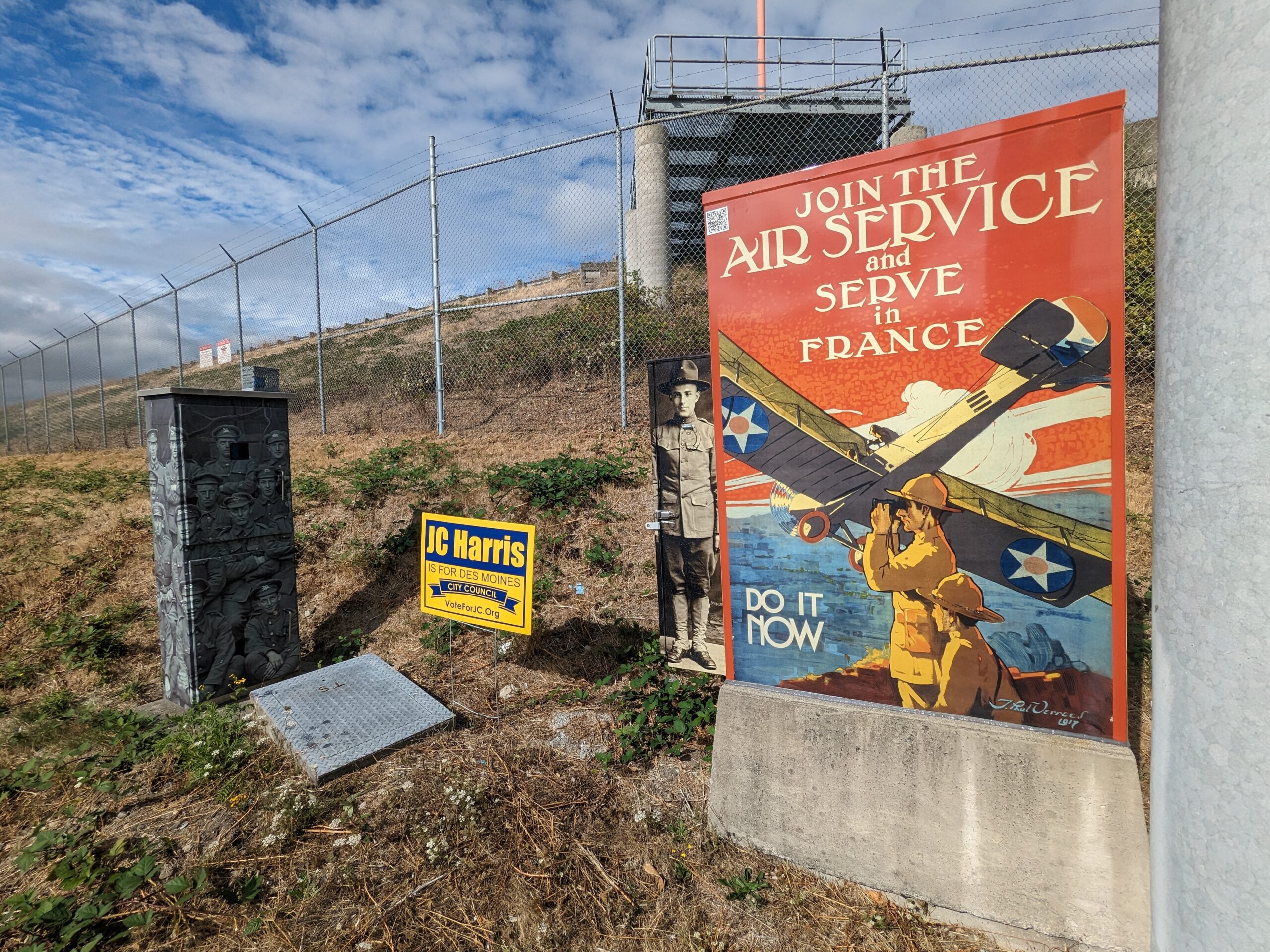
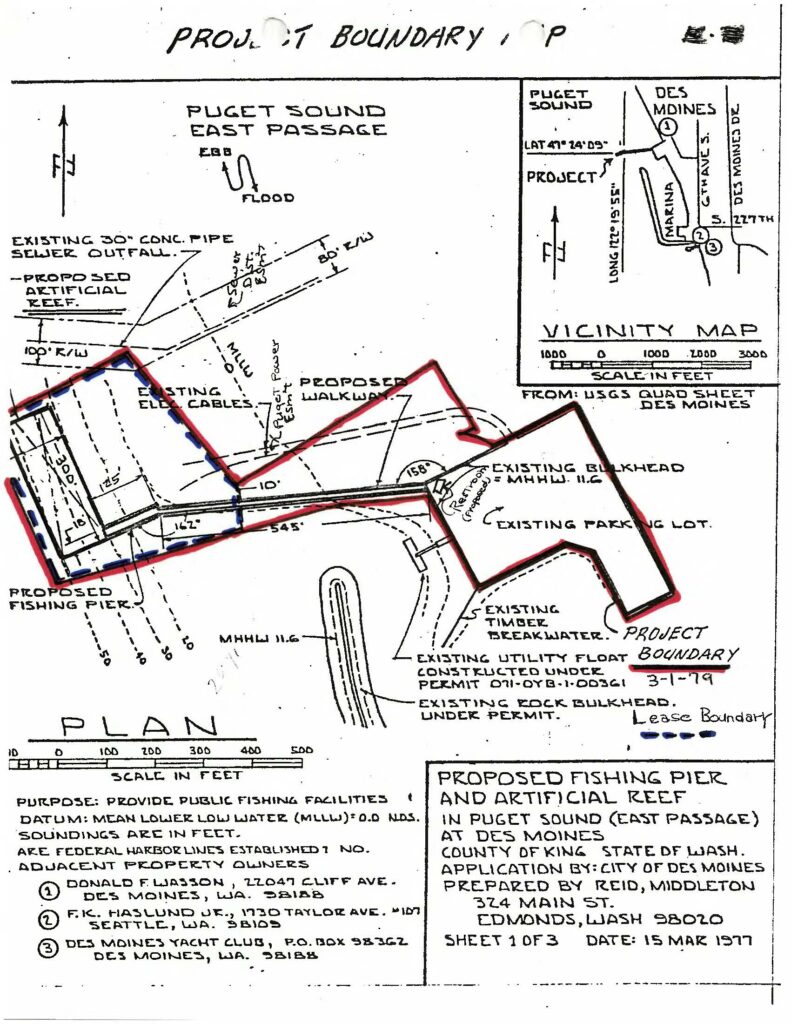

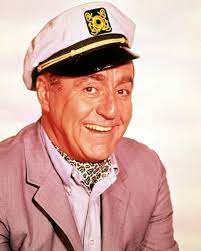

This is a wonderful description of the time line. Thank you so much!
Thank you for all your hard work. Can you please tell me what the purpose/official role of the city council is? It seems like if we start at the beginning and analyze what decisions have been appropriate for the council to make, it would help now. I have never heard of a city council entering into development deals with private companies.
Are average citizens allowed to ask questions at council meetings? I have attended some meetings, and it seems like there hasn’t been a time to just ask for clarification on what is happening in Des Moines.
Again, thanks so much for all your work!
Des Moines has a Council/Manager form of government. The most common analogy is that the City Manager runs the city like the CEO of a corporation and the Council is the board of directors that votes on broad policy directives but to avoid chaos and/or corruption plays no role in day to day operations.
By State law, the Council is required to approve the annual budget and large scale spending. It can propose and approve legislation–or approve legislation proposed by the City Manager.
Beyond that, most everything else is for grabs depending on the City you live in. For example, in some cities, the Council plays a very active role in generating legislation. In some the Council plays a very active role in oversight of various departments. In others (like Des Moines), it plays almost no role in either. In all cases, those roles are defined by the Council majority itself.
Council/Manager Government is almost 100% “majority rules”.
For example, in Des Moines in 2023, if the City Manager, or any employee of the City is uncooperative in any way, I can complain—to the City Manager and he is free to ignore me.Theoretically, I could then complain to the Council. But if I don’t have four votes, nothing happens. There is no other “ethics police” besides the Council majority itself.
Crazy! The ferry project and the amount of money it swallowed is beyond negligent. It is a perfect illustration of how inept the Des Moines governance is. I have very little hope that anything changes for the better. The incompetence and spending habits are out of control.
It certainly appears that the majority of residents of our sleepy town are either content, or don’t care about any of it.
This is very well written, JC. Thanks for putting this together. The marina is jewel for the city and the county in terms of recreation, and I think it should be made available for as many users as possible.
The boaters in the community do miss the sling very much. It is a very strange situation to live in Des Moines that has a marina, but have to launch at Redondo. Redondo can pretty hairy to launch at with the number of pedestrians and car traffic right at the launch.
How dead is the new sling discussion? Have other alternatives been looked at such as a ramp? Throwing out ideas: a ramp could be put in at the end of 227th, or where the Tenant Sling is still standing?
And one final idea. The pedestrian ferry was great when it ran. If the city wants to run a ferry with a lower barrier to entry, how about we start with a summer pedestrian ferry to the Maury Island Point Robinson Lighthouse? There are many examples of shore landing pedestrian ferries. It’d be a good way to get people on the water with views of Mt Rainier.
The current funding for the marina puts off the boat launch until 2030-ish, partly because there is no agreement on dry stack storage–which will determine what kind of boat launch is built. I strongly favour dry stack and am working to move that discussion into the near term.
The pedestrian ferry is a wonderful idea. Unfortunately, it lost hundreds of thousands of dollars–just during that short run. And it would continue to do so unless/until some other agency comes along to pay for it. If you watch our meetings, you’ll see why I fought so hard against it. We’ve had financial challenges that have been brewing for a long time. But as a long time boater, I do agree with the concept. Nothing better than watching orcas and the masonic home from Pt. Robinson. 🙂